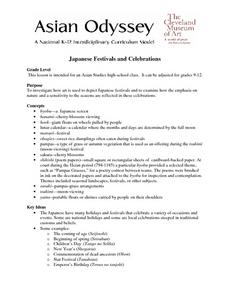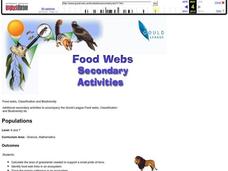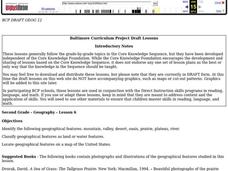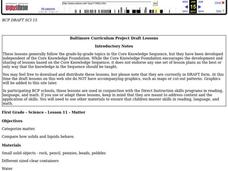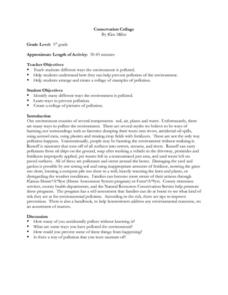Curated OER
What's It All About?- Kansas Prairies
Students examine the interdependence of animal life and the environment. In this Kansas prairies lesson, students read background information on prairies and complete a worksheet to identify the main idea.
Curated OER
Explorit's Foodplant Quiz
In this plants worksheet, students complete a five question multiple choice on-line interactive quiz about plants grown for food.
Curated OER
SAV Plants of the St. Mary¿¿¿s River Ecosystem
Students examine the importance of submerged aquatic vegetation in the St. Mary River ecosystem. They identify different characteristics of common eelgrass and discuss water quality, photosynthesis, habitat, oxygen production.
Curated OER
Identifying plants, animals, insects, reptiles, and birds on the prairie
Young scholars identify all of the plant an animal life on the prairie. In this plant identification lesson students divide into groups and draw sketches of things they saw on the prairie.
Curated OER
Japanese Festivals and Celebrations
High schoolers investigate the importnce of celebrations anf festivals in Japanese culture and then create a story based upon an image from the instructional activity. Resource links are provided for images of events.
Curated OER
Populations
Students calculate the area of grasslands needed to support a small pride of lions. They also identify food web links in an ecosystem and trace the energy pathways in an ecosystem.
Curated OER
What does AG have to do with me?
Young scholars practice alphabetizing while categorizing sources of basic agricultural products. They discuss agricultrual products, discover where they are grown and draw a simple agricultural scene on poster board.
Curated OER
Look Out, Below!
Students study the four layers of soil while identifying the substances that each level is composed up. They investigate the properties of soil such as color, texture, water retention and the ability to maintain life by growing a plant.
Curated OER
How Manduca See
Third graders investigate how manduca sees and they discuss what they think the manduca might be thinking. They write a story about what an insect sees and does from the insect's perspective.
Curated OER
Grow Your Own
Students study the growth and care of plants. They take tour of their school site and plant seeds to observe their growth. Afterward, they answer questions about the origin and value of their plants.
Curated OER
Meadow Study
Students examine insects they collect in a sweep nets. They identify as many of the insects as they can.
Curated OER
Nature Reflections
Students have a greater appreciation for the nature around them. They participate in a series of reflection exercises. Students encounter blindfolds, and bandannas with cardboards as bases.
Curated OER
Class Tales
Students improve their reading comprehension by role-playing a bear hunt story. In this reading comprehension lesson, students pretend to go on a bear hunt and complete an art project for the story.
Curated OER
Birds of Wisconsin
First graders explore the job done by ornithologists. They role play identifying the characteristics that make a bird a bird. They discuss what makes each bird species unique. Students are introduced to Wisconsin's most common and rare...
Curated OER
Time, Tide, and Quahogs
Students read tide tables for Waquoit Bay as the simulate determining the best time to go clam digging for a Wampanoag clambake. They graph the tide tables while realizing that the tides a Waquoit Bay are one hour later than those at...
Curated OER
African Elephants
For this elephant worksheet, students read several factual paragraphs about African elephants. Students then answer several questions about the animals.
Curated OER
Match Words: Toxins
In this toxin matching activity, students draw a line from a toxin to a picture that shows where it might be found in a home. Students then match 5 words [toxins] to their descriptions.
Curated OER
Frog External Anatomy
Sixth graders study frog anatomy. In this frog anatomy instructional activity students examine a frog including the anatomy of its mouth and fill out a worksheet.
Curated OER
Wheat: Ancient and Ageless
Students label the parts of a wheat plant on a worksheet. In this Egyptian farming activity, students thresh a wheat stem and estimate the amount harvested. Students research Ancient Egypt online.
Curated OER
Geography
Second graders study and review geographical terms for features. They classify those features and locate them on a map. They review geographical features of Tall Tales.
Curated OER
Conservation Collage
Students identify many different ways the environment is polluted, and determine ways to prevent pollution. They create a collage of pictures describing how the earth becomes polluted.
Curated OER
Houses in Japan
First graders compare the everday lives of school-aged children in the United States and Japan by comparing the houses they live in. They discuss how traditional Japanese houses are designed with a feeling of opennes to the outdoors and...
Curated OER
Pollen Collection And Identification
High schoolers investigate plant reproduction, pollen collection and identification. They collect pollen samples over a twenty four hour period and examine them under a microscope.




